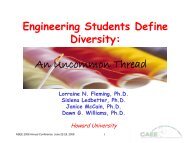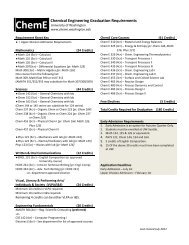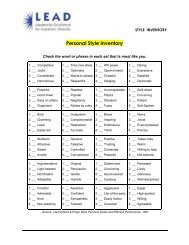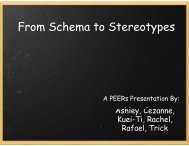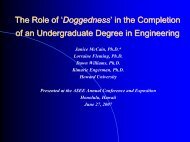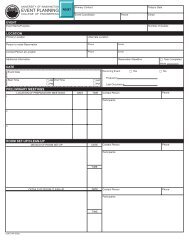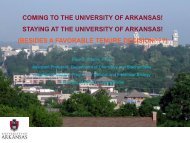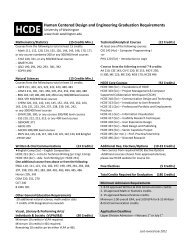Research Stars Light the Path - College of Engineering - University ...
Research Stars Light the Path - College of Engineering - University ...
Research Stars Light the Path - College of Engineering - University ...
- No tags were found...
You also want an ePaper? Increase the reach of your titles
YUMPU automatically turns print PDFs into web optimized ePapers that Google loves.
<strong>Research</strong><strong>Stars</strong><strong>Light</strong> <strong>the</strong> <strong>Path</strong>The call came out <strong>of</strong> <strong>the</strong> blue to Yoky Matsuoka, associatepr<strong>of</strong>essor <strong>of</strong> computer science and engineering.An <strong>of</strong>ficial from <strong>the</strong> John D. and Ca<strong>the</strong>rine T. MacArthurFoundation instructed Matsuoka to sit down and putdown her week-old baby. Then he revealed she had wona 2007 MacArthur Fellowship, <strong>the</strong> so-called “geniusaward” with a $500,000 no-strings-attached prize.Matsuoka directs <strong>the</strong> UW Neurobotics Laboratory.She studies how our central nervous system producessignals that control movements <strong>of</strong> <strong>the</strong> limbs and <strong>the</strong>nuses that information to create advanced robotic pros<strong>the</strong>tics.Her team is working on a lifelike robotic handthat could approximate natural motion, directed by aperson’s brain and nerve signals.Associate Pr<strong>of</strong>essor Yoky Matsuoka and undergraduate Carissa Conwayexamine <strong>the</strong> robot hand, a step toward a lifelike pros<strong>the</strong>sis.Matusoka said. “That was a big turning point. I realizedthat acting airhead was not <strong>the</strong> right dual life for me.”Matsuoka also is on a mission to pave <strong>the</strong> way foryoung women interested in science by changing <strong>the</strong>image and ensuring <strong>the</strong>m it’s okay to be smart. “I’d liketo be a role model. I want <strong>the</strong>m to see what I’m doingand encourage <strong>the</strong>m to do better than me,” she said.Carissa Conway, a computer science junior, is watchingclosely. This past summer she participated in <strong>the</strong> Intel<strong>Research</strong> Experience for Undergraduates. “I was ecstaticthat Yoky chose me to work in her lab,” Carissa said.She contributed to <strong>the</strong> research by developing a 3Dcomputer representation <strong>of</strong> a skeletal finger. It uses afeedback device to take data on <strong>the</strong> velocity and positionUW <strong>Engineering</strong> wants to greatly expand research opportunities for undergraduates and encourage more womento pursue careers in engineering. In <strong>the</strong>se pages we introduce you to three women on our faculty who are mentoringyoung women. Any faculty member, male or female, can be a first-rate mentor to any student, male or female, but in afield where men predominate, an extra dash <strong>of</strong> inspiration seems to infuse woman-to-woman mentorship.Matsuoka earned a BS degree from UC–Berkeleyand a PhD from MIT, both in electrical engineering andcomputer science. UW CSE recruited her in 2006 from<strong>the</strong> Carnegie Mellon faculty. Winning <strong>the</strong> MacArthurhas earned her worldwide media coverage, including aPBS NOVA segment in July, a story in <strong>the</strong> September 25Nature, and participation in <strong>the</strong> New Yorker’s “Storiesfrom <strong>the</strong> Future” conference last May.Matusoka is just one highly visible example <strong>of</strong> <strong>the</strong>extraordinary women on <strong>the</strong> <strong>Engineering</strong> faculty, all <strong>of</strong>whom value <strong>the</strong> opportunity to introduce <strong>the</strong> challengesand excitement <strong>of</strong> research to women undergrads.She also is light years removed from <strong>the</strong> super-smartteenager who didn’t want to be perceived as a math andscience nerd and so pretended she never studied. The“airhead” act worked until her second year at MIT.“My advisor pulled me aside and told me to stop it,”<strong>of</strong> <strong>the</strong> tip <strong>of</strong> a user’s index finger. “The virtual finger willexecute <strong>the</strong> same motions as <strong>the</strong> user’s finger,” Conwaysaid. “This allows us to test passive behaviors in a virtualenvironment before transferring <strong>the</strong>m to <strong>the</strong> robot hand.”Not many girls at her high school in Tenino wereinterested in math and science, so she is happy to beat <strong>the</strong> UW. “I just love solving problems and workingthrough <strong>the</strong> code. Debugging it and getting it to work issuch a joy,” Conway said. “Being part <strong>of</strong> a research teamis definitely challenging and has taught me a ton.”Conway hopes to pursue a doctorate in computerscience and <strong>the</strong>n do research in academia or industry.“Yoky has been so supportive and it’s just awesomeworking with her,” Conway said. “It’s nice to have awoman to look up to. She’s an inspiration.” Cont. pg 6• To learn more about Matsuoka and <strong>the</strong> Neurobotics Lab:http://www.cs.washington.edu/homes/yoky/TREND • Vol 58:2 • Autumn 2008 5



